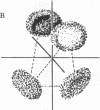Abstract
The anomalous dispersion of iron at its K-absorption edge in small-angle scattering of an aqueous solution of hemoglobin has been used to establish the geometrical arrangement of the four iron atoms in this protein. Although the anomalous contributions are 0.001-0.01 of the total scattering, experiments with synchrotron radiation from the storage ring DORIS have shown that these effects can be measured with an average precision of approximately 10% at each of the 50 points of the scattering curve. The anomalous scattering represents the convolution of the whole structure with the configuration of the four iron atoms of hemoglobin. Analysis in terms of multipoles suggests that tetrahedral symmetry of both the subunit arrangement and the iron structure is a dominant feature. The mean distance between the iron atoms of 26 A derived from this experiment compares well with that derived from crystallographic data.
Full text
PDF




Images in this article
Selected References
These references are in PubMed. This may not be the complete list of references from this article.
- Baldwin J., Chothia C. Haemoglobin: the structural changes related to ligand binding and its allosteric mechanism. J Mol Biol. 1979 Apr 5;129(2):175–220. doi: 10.1016/0022-2836(79)90277-8. [DOI] [PubMed] [Google Scholar]
- Conrad H., Mayer A., Schwaiger S., Schneider R. Kleinwinkelstreuung mit Röntgenstrahlen an Hämoglobin und dessen isolierten Untereinheiten in wässriger Lösung. Hoppe Seylers Z Physiol Chem. 1969 Jul;350(7):845–850. [PubMed] [Google Scholar]
- Langer J. A., Engelman D. M., Moore P. B. Neutron-scattering studies of the ribosome of Escherichia coli: a provisional map of the locations of proteins S3, S4, S5, S7, S8 and S9 in the 30 S subunit. J Mol Biol. 1978 Mar 15;119(4):463–485. doi: 10.1016/0022-2836(78)90197-3. [DOI] [PubMed] [Google Scholar]
- Lye R. C., Phillips J. C., Kaplan D., Doniach S., Hodgson K. O. White lines in L-edge x-ray absorption spectra and their implications for anomalous diffraction studies of biological materials. Proc Natl Acad Sci U S A. 1980 Oct;77(10):5884–5888. doi: 10.1073/pnas.77.10.5884. [DOI] [PMC free article] [PubMed] [Google Scholar]
- Phillips J. C., Templeton D. H., Templeton L. K., Hodgson K. O. LIII-Edge Anomalous X-ray Scattering by Cesium Measured with Synchrotron Radiation. Science. 1978 Jul 21;201(4352):257–259. doi: 10.1126/science.201.4352.257. [DOI] [PubMed] [Google Scholar]
- Schelten J., Schlecht P., Schmatz W., Mayer A. Neutron small angle scattering of hemoglobin. J Biol Chem. 1972 Sep 10;247(17):5436–5441. [PubMed] [Google Scholar]
- Stuhrmann H. B. Comparison of the three basic scattering functions of myoglobin in solution with those from the known structure in crystalline state. J Mol Biol. 1973 Jul 5;77(3):363–369. doi: 10.1016/0022-2836(73)90444-0. [DOI] [PubMed] [Google Scholar]
- TenEyck L. F., Arnone A. Three-dimensional Fourier synthesis of human deoxyhemoglobin at 2-5 A resolution I. X-ray analysis. J Mol Biol. 1976 Jan 5;100(1):3–11. doi: 10.1016/s0022-2836(76)80029-0. [DOI] [PubMed] [Google Scholar]




